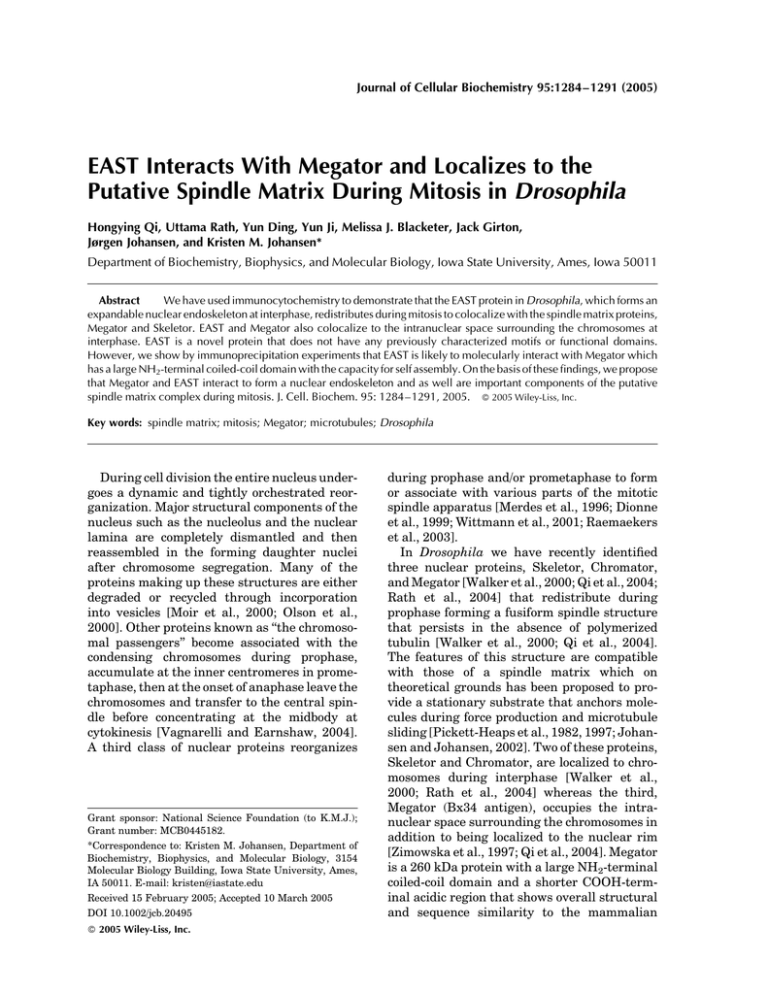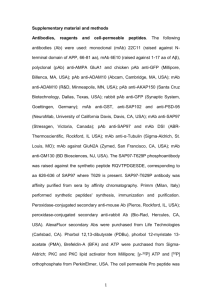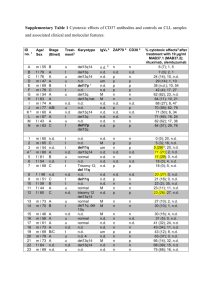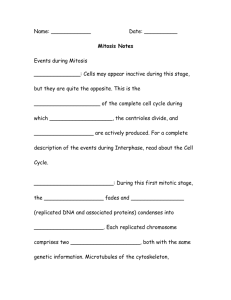EAST Interacts With Megator and Localizes to the
advertisement

Journal of Cellular Biochemistry 95:1284–1291 (2005) EAST Interacts With Megator and Localizes to the Putative Spindle Matrix During Mitosis in Drosophila Hongying Qi, Uttama Rath, Yun Ding, Yun Ji, Melissa J. Blacketer, Jack Girton, Jørgen Johansen, and Kristen M. Johansen* Department of Biochemistry, Biophysics, and Molecular Biology, Iowa State University, Ames, Iowa 50011 Abstract We have used immunocytochemistry to demonstrate that the EAST protein in Drosophila, which forms an expandable nuclear endoskeleton at interphase, redistributes during mitosis to colocalize with the spindle matrix proteins, Megator and Skeletor. EAST and Megator also colocalize to the intranuclear space surrounding the chromosomes at interphase. EAST is a novel protein that does not have any previously characterized motifs or functional domains. However, we show by immunoprecipitation experiments that EAST is likely to molecularly interact with Megator which has a large NH2-terminal coiled-coil domain with the capacity for self assembly. On the basis of these findings, we propose that Megator and EAST interact to form a nuclear endoskeleton and as well are important components of the putative spindle matrix complex during mitosis. J. Cell. Biochem. 95: 1284–1291, 2005. ! 2005 Wiley-Liss, Inc. Key words: spindle matrix; mitosis; Megator; microtubules; Drosophila During cell division the entire nucleus undergoes a dynamic and tightly orchestrated reorganization. Major structural components of the nucleus such as the nucleolus and the nuclear lamina are completely dismantled and then reassembled in the forming daughter nuclei after chromosome segregation. Many of the proteins making up these structures are either degraded or recycled through incorporation into vesicles [Moir et al., 2000; Olson et al., 2000]. Other proteins known as ‘‘the chromosomal passengers’’ become associated with the condensing chromosomes during prophase, accumulate at the inner centromeres in prometaphase, then at the onset of anaphase leave the chromosomes and transfer to the central spindle before concentrating at the midbody at cytokinesis [Vagnarelli and Earnshaw, 2004]. A third class of nuclear proteins reorganizes Grant sponsor: National Science Foundation (to K.M.J.); Grant number: MCB0445182. *Correspondence to: Kristen M. Johansen, Department of Biochemistry, Biophysics, and Molecular Biology, 3154 Molecular Biology Building, Iowa State University, Ames, IA 50011. E-mail: kristen@iastate.edu Received 15 February 2005; Accepted 10 March 2005 DOI 10.1002/jcb.20495 ! 2005 Wiley-Liss, Inc. during prophase and/or prometaphase to form or associate with various parts of the mitotic spindle apparatus [Merdes et al., 1996; Dionne et al., 1999; Wittmann et al., 2001; Raemaekers et al., 2003]. In Drosophila we have recently identified three nuclear proteins, Skeletor, Chromator, and Megator [Walker et al., 2000; Qi et al., 2004; Rath et al., 2004] that redistribute during prophase forming a fusiform spindle structure that persists in the absence of polymerized tubulin [Walker et al., 2000; Qi et al., 2004]. The features of this structure are compatible with those of a spindle matrix which on theoretical grounds has been proposed to provide a stationary substrate that anchors molecules during force production and microtubule sliding [Pickett-Heaps et al., 1982, 1997; Johansen and Johansen, 2002]. Two of these proteins, Skeletor and Chromator, are localized to chromosomes during interphase [Walker et al., 2000; Rath et al., 2004] whereas the third, Megator (Bx34 antigen), occupies the intranuclear space surrounding the chromosomes in addition to being localized to the nuclear rim [Zimowska et al., 1997; Qi et al., 2004]. Megator is a 260 kDa protein with a large NH2-terminal coiled-coil domain and a shorter COOH-terminal acidic region that shows overall structural and sequence similarity to the mammalian EAST Interacts With Megator nuclear pore complex Tpr protein [Zimowska et al., 1997]. Another large protein in Drosophila that associates with an interior nonchromosomal compartment of the interphase nucleus is EAST [Wasser and Chia, 2000, 2003]. Loss-of-function east mutations lead to an increased frequency of mitotic errors as well as to abnormal congression of chromosomes in prometaphase [Wasser and Chia, 2003]. Here we show using cross-immunoprecipitations and immunocytochemistry that EAST interacts with Megator and that EAST colocalizes with Skeletor and Megator to the putative spindle matrix as it is defined by these proteins during mitosis. MATERIALS AND METHODS Drosophila Stocks Fly stocks were maintained according to standard protocols [Roberts, 1986]. Oregon-R or Canton-S was used for wild-type preparations. Antibodies Residues 242–480 and 704–820 of the predicted EAST protein [Wasser and Chia, 2000] were subcloned using standard techniques [Sambrook et al., 1989] into the pGEX-4T-1 vector (Amersham Pharmacia Biotech, Piscataway, NJ) to generate the constructs GST-239 and GST-117. The correct orientation and reading frame of the inserts were verified by sequencing. The GST-239 and GST-117 fusion proteins were expressed in XL1-Blue cells (Stratagene, La Jolla, CA) and purified over a glutathione agarose column (Sigma-Aldrich, St. Louis, MO), according to the pGEX manufacturer’s instructions (Amersham Pharmacia Biotech). The mAb 5B1 was generated by injection of 50 mg of GST-239 into BALB/c mice at 21 day intervals. After the third boost, mouse spleen cells were fused with Sp2 myeloma cells and monospecific hybridoma lines were established using standard procedures [Harlow and Lane, 1988]. The mAb 5B1 is of the IgM subtype. All procedures for mAb production were performed by the Iowa State University Hybridoma Facility. Anti EAST IgY antibodies were purified from eggs of chickens that had been injected with the purified GST-117 fusion protein by Aves Labs. The anti-Skeletor mAb 1A1 [Walker et al., 2000], anti-Megator mAb 12F10 [Qi et al., 2004], and the anti-EAST polyclonal mouse antiserum ED3 [Wasser and 1285 Chia, 2000] have been previously described. An anti-a-tubulin rat mAb was obtained from a commercial source (Abcam). Biochemical Analysis SDS–PAGE and immunoblotting. SDS– PAGE was performed according to standard procedures (Laemmli, 1970). Electroblot transfer was performed as in Towbin et al. [1979] with transfer buffer containing 20% methanol and in most cases including 0.04% SDS. For these experiments, we used the Bio-Rad Mini PROTEAN II system, electroblotting to 0.2 mm nitrocellulose, and using anti-mouse HRP-conjugated secondary antibody (Bio-Rad) (1:3,000) for visualization of primary antibody diluted 1:1,000 in Blotto. The signal was visualized using chemiluminescent detection methods (ECL kit, Amersham). Immunoprecipitation assays. For coimmunoprecipitation experiments, anti-Megator (mAb 12F10) or anti-EAST antibodies (mAb 5B1 or pAb ED3) were bound to 30 ml protein-G Sepharose beads (Sigma) for 2.5 h at 48C on a rotating wheel in 50 ml ip buffer (20 mM TrisHCl pH 8.0, 10 mM EDTA, 1 mM EGTA, 150 mM NaCl, 0.1% Triton X-100, 0.1% Nonidet P-40, 1 mM Phenylmethylsulfonyl fluoride, and 1.5 mg Aprotinin). The appropriate antibody-coupled beads or beads only were incubated overnight at 48C with 200 ml of S2 cell lysate on a rotating wheel. Beads were washed three times for 10 min each with 1 ml of ip buffer with low speed pelleting of beads between washes. The resulting bead-bound immunocomplexes were analyzed by SDS–PAGE and Western blotting according to standard techniques [Harlow and Lane, 1988] using mAb 12F10 to detect Megator and pAb ED3 to detect EAST. Immunohistochemistry Antibody labeling of 0–3 h embryos were performed as previously described [Johansen et al., 1996; Johansen and Johansen, 2003]. The embryos were dechorionated in a 50% Chlorox solution, washed with 0.7M NaCl/0.2% Triton X-100 and fixed in a 1:1 heptane:fixative mixture for 20 min with vigorous shaking at room temperature. The fixative was either 4% paraformaldehyde in phosphate buffered saline (PBS) or Bouin’s fluid (0.66% picric acid, 9.5% formalin, and 4.7% acetic acid). Vitelline membranes were then removed by shaking embryos in heptane-methanol [Mitchison and Sedat, 1286 Qi et al. 1983] at room temperature for 30 s. Double and triple labelings employing epifluorescence were performed using various combinations of antibodies against Megator (mAb 12F10, IgG1), EAST (mAb 5B1, IgM; pAb ED3; pAb IgY), Skeletor (mAb 1A1, IgM), anti-a-tubulin rat IgG2a, and Hoechst to visualize the DNA. The appropriate species and isotype specific Texas Red-, TRITC-, and FITC-conjugated secondary antibodies (Cappel/ICN, Southern Biotech) were used (1:200 dilution) to visualize primary antibody labeling. Confocal microscopy was performed with a Leica confocal TCS NT microscope system equipped with separate Argon-UV, Argon, and Krypton lasers and the appropriate filter sets for Hoechst, FITC, Texas Red, and TRITC imaging. A separate series of confocal images for each fluorophor of double labeled preparations were obtained simultaneously with z-intervals of typically 0.5 mm using a PL APO 100X/1.40–0.70 oil objective. A maximum projection image for each of the image stacks was obtained using the ImageJ software (http://rsb.info.nih.gov/ij/). In some cases individual slices or projection images from only two to three slices were obtained. Images were imported into Photoshop where they were pseudocolored, image processed, and merged. In some images non-linear adjustments were made for optimal visualization especially of Hoechst labelings of nuclei and chromosomes. Polytene chromosome squash preparations from late third instar larvae were immunostained by EAST antibodies and Megator antibody essentially as previously described by Zink and Paro [1989], Jin et al. [1999], and by Wang et al. [2001]. Fig. 1. The dynamic redistribution of EAST relative to the putative spindle matrix protein Skeletor during the cell cycle. The images are from triple labelings of EAST with pAb ED3 (green), Skeletor with mAb 1A1 (red), and with Hoechst (blue). The composite images (comp) are shown to the left. During prophase, metaphase, and telophase the composite images (comp) show extensive overlap between Megator and Skeletor labeling as indicated by the yellow color. The images are from confocal sections of syncytial embryonic nuclei. [Color figure can be viewed in the online issue, which is available at www.interscience. wiley.com.] RESULTS The interphase localization of EAST to the extrachromosomal nuclear domain [Wasser and Chia, 2000] is very similar to that of the putative spindle matrix protein Megator [Qi et al., 2004]. Furthermore, considerable EAST immunoreactivity has been reported to be present around the metaphase plate during mitosis although the exact nature of this labeling was not EAST Interacts With Megator resolved [Wasser and Chia, 2000, 2003]. For these reasons, we revisited the issue of EAST antibody labeling during the cell cycle in syncytial Drosophila embryos fixed with Bouin’s fluid, a precipitative fixative characterized by its rapid penetration and efficient fixation of nuclear proteins [Johansen and Johansen, 2003]. Figure 1 shows double labelings with EAST antibody and the mAb 1A1 to the spindle matrix protein, Skeletor [Walker et al., 2000]. The EAST antibody is the mouse antiserum (pAb ED3) used in the original EAST localization study by Wasser and Chia, [2000]. The double labeling were made possible by the fact that mAb 1A1 is of the IgM subtype that can be selectively recognized with TRITC-conjugated IgM specific secondary antibody and that EAST pAb ED3 can be detected with FITCconjugated IgG (IgG1, IgG2A, IgG2B) specific secondary antibody that does not cross react with IgM antibody. Furthermore, control experiments in which pAb ED3 single labeling were incubated with the TRITC-conjugated IgM secondary antibody showed that the EAST antiserum contained no detectable levels of EAST antibody of the IgM subtype at the antibody dilutions used for staining. Therefore, there was no cross reactivity in the detection of the two antigens in the employed labeling protocol. Figure 1 shows that as mitosis commences EAST reorganizes during prophase into a fusiform spindle structure the pattern of which during metaphase appears identical to that of the putative spindle matrix protein Skeletor. At telophase both EAST and Skeletor redistribute back to the forming daughter nuclei. This localization of EAST during mitosis was also obtained in single labeling studies with pAb ED3 (data not shown). In order to further confirm these findings and to generate probes for double labeling experiments with other potential spindle matrix proteins, we made new EAST antibodies against GST fusion proteins containing residues 242–480 and 704–820 of the EAST protein. One antibody was a chicken antiserum (pAb IgY) that labels a single protein band of !265 kDa on immunoblots of S2 cell extracts consistent with the predicted molecular mass of EAST of 253 kDa (Fig. 2A). This band is also labeled by the original EAST antibody pAb ED3 (Fig. 2A). A second antibody we generated was a mouse monoclonal antibody (mAb) 5B1. mAb 5B1 is of the IgM subtype and did not label 1287 Fig. 2. EAST antibody labeling of immunoblots of S2 cell lysates. A: Western blot analysis of protein extracts from S2 cells shows that both pAb ED3 and pAb IgY recognize EAST protein as a 265 kDa band. The relative migration of molecular weight markers in kDa are indicated to the right in grey numerals. B: Immunoprecipitation (ip) of S2 cell lysate was performed using the mAb 5B1 (lane 3) coupled to immunobeads or with immunobeads only as a control (lane 2). The immunoprecipitations were analyzed by SDS–PAGE and Western blotting using EAST pAb ED3 for detection. EAST pAb ED3 staining of S2 cell lysate is shown in lane 1. EAST is detected in the mAb 5B1 immunoprecipitation sample as a 265 kDa band (lane 3) but not in the control sample (lane 2). immunoblots. However, in immunoprecipitation assays of S2 cell lysates mAb 5B1 immunoprecipitated a 265 kDa protein detected by the EAST antibody pAb ED3 (Fig. 2B). A similarly sized band was labeled by pAb ED3 in the S2 cell lysate but not in the beads only immunoprecipitation control (Fig. 2B). These findings demonstrate that mAb 5B1 immunoprecipitates the EAST protein. Immunocytologically, the staining patterns of pAb IgY and mAb 5B1 were indistinguishable from that of pAb ED3 in 1288 Qi et al. the polytene salivary gland and early syncytial embryo preparations examined. To address the relationship between EAST and Megator localization in interphase nuclei as well as during mitosis, we used the newly generated antibodies for double labeling studies. Figure 3 shows such labeling with EAST pAb IgY and Megator mAb 12F10 of light squashes of polytene salivary gland nuclei where both EAST and Megator labeling surround the chromosomes. Furthermore, EAST and Megator appear to colocalize as indicated by the predominantly yellow color in the composite image of Figure 3D. Figure 4A shows the relative distribution of EAST as labeled by mAb 5B1 and Megator as labeled by mAb 12F10 during mitosis in syncytial Drosophila embryos. Both proteins reorganize as mitosis commences into fusiform spindle structures at metaphase where the two proteins are colocalized (Fig. 4A) and where the EAST-defined spindle is co-aligned with the microtubule spindle apparatus (Fig. 4B). At telophase EAST redistributes back to the forming daughter nuclei whereas Megator can be observed only in the spindle midbody. Thus, while EAST and Megator mostly are colocalized during the cell cycle their distributions are not identical. Another difference is that Megator shows strong localization to the nuclear rim during interphase and prophase whereas EAST does not (Fig. 4A) suggesting that EAST and Megator may have overlapping as well as distinct functions in the interphase nucleus. The extensive overlap in the distribution of EAST and Megator suggested that the two proteins might interact within the same molecular complex in vivo. To test this possibility, we performed co-immunoprecipitation experiments. In these assays proteins were extracted from S2 cell lysates, immunoprecipitated with EAST or Megator antibody, fractionated on SDS–PAGE after the immunoprecipitation, immunoblotted, and probed with EAST or Megator antibody, respectively. Figure 5A shows that the Megator mAb 12F10 pulled down EAST protein as a 265 kDa band that is also detected in the S2 cell lysate but is not present in the control immunoprecipitated with immunobeads only. Figure 5B shows the converse experiment where EAST pAb ED3 pulled down a 260 kDa band detected by Megator mAb 12F10 that was also present in the lysate but not in the immunobeads only control. A similar result was obtained with EAST mAb 5B1 (Fig. 5C). These results indicate that EAST and Megator are present in the same protein complex. Fig. 3. Light squash of a larval polytene nucleus where the chromosomes are surrounded by EAST and Megator labeling. The images are from a triple labeling of EAST with pAb IgY (green), Megator with mAb 12F10 (red), and the DNA with Hoechst (blue). The composite image in (A) shows that EAST surrounds the chromosomes and the composite image in (D) shows that Megator and EAST largely co-localize as indicated by the predominantly yellow color. [Color figure can be viewed in the online issue, which is available at www.interscience.wiley. com.] DISCUSSION In this study, we show that in addition to the previously reported localization of EAST to the extrachromosomal space at interphase [Wasser and Chia, 2000], during mitosis EAST redistributes to colocalize with the putative spindle matrix proteins, Skeletor, and Megator [Walker et al., 2000; Qi et al., 2004]. Based on overexpression studies of EAST in polyploid cells, it EAST Interacts With Megator 1289 Fig. 4. The localization of EAST relative to the putative spindle matrix protein Megator and to tubulin during the cell cycle. A: The images are from triple labeling of EAST with mAb 5B1 (green), Megator with mAb 12F10 (red), and DNA with Hoechst (blue). The composite images (comp) are shown to the left. At prophase EAST and Megator labeling overlap in the nuclear interior whereas Megator labeling is prominent at the nuclear rim. During metaphase the composite image (comp) shows extensive overlap between EAST and Megator labeling as indicated by the predominantly yellow color. At telophase where EAST begins to redistribute back around the chromosomes Megator appears to be preferentially localized to the spindle midbody. B: The images are from triple labeling of EAST with mAb 5B1 (green), tubulin with a rat anti-a-tubulin mAb (red), and DNA with Hoechst (blue). The EAST antibody clearly labels a true fusiform spindle structure that is co-aligned with the microtubule spindle except for the centrosomes. The images in (A) and (B) are from confocal sections of syncytial embryonic nuclei. [Color figure can be viewed in the online issue, which is available at www.interscience.wiley.com.] has been proposed that EAST may be part of an internal nucleoskeleton that at interphase regulates nuclear volume and the distribution of some nuclear proteins such as CP60 and actin [Wasser and Chia, 2000]. However, recent studies of chromosome behavior in east loss-offunction mutations during mitosis and meiosis suggested that EAST may also play an important role in the congression and alignment of chromosomes during prophase and prometaphase as well as in regulating chromosome movement at metaphase [Wasser and Chia, 2003]. Interestingly, abnormal chromosome localization in east mutants can be observed in prophase of male meiosis before nuclear envelope breakdown and before the chromosomes can establish interactions with microtubules [Wasser and Chia, 2003]. These findings provide evidence that EAST may function to guide or constrain chromosome congression [Wasser and Chia, 2003]. Moreover, the continued colocalization of EAST with Megator during prophase suggests that Megator may interact with EAST to play a role in this process as well. When Megator levels were knocked down by RNAi in S2 cell cultures no defects in tubulin spindle 1290 Qi et al. Fig. 5. EAST and Megator immunoprecipitation assays. A: Immunoprecipitation (ip) of S2 cell lysate was performed using the Megator mAb 12F10 (lane 3) coupled to immunobeads or with immunobeads only as a control (lane 2). The immunoprecipitations were analyzed by SDS–PAGE and Western blotting using EAST pAb ED3 for detection. EAST pAb ED3 staining of S2 cell lysate is shown in lane 1. EAST is detected in the Megator ip sample as a 265 kDa band (lane 3) but not in the control sample (lane 2). B: Immunoprecipitation of S2 cell lysate was performed using EAST pAb ED3 (lane 3) coupled to immunobeads or with immunobeads only as a control (lane 2). The immunoprecipitations were analyzed by SDS–PAGE and Western blotting using Megator mAb 12F10 for detection. Megator mAb 12F10 staining of S2 cell lysate is shown in lane 1. Megator is detected in the EAST immunoprecipitation sample as a 260 kDa band (lane 3) but not in the control sample (lane 2). C: Immunoprecipitation (ip) of S2 cell lysate was performed using EAST mAb 5B1 (lane 3) coupled to immunobeads or with immunobeads only as a control (lane 2). The immunoprecipitations were analyzed by SDS– PAGE and Western blotting using Megator mAb 12F10 for detection. Megator mAb 12F10 staining of S2 cell lysate is shown in lane 1. Megator is detected in the EAST immunoprecipitation sample as a 260 kDa band (lane 3) but not in the control sample (lane 2). morphology or chromosome segregation were apparent; however a significant reduction in the number of cells undergoing mitosis was observed suggesting that depletion of Megator prevents cells from entering metaphase [Qi et al., 2004]. These results suggest that both EAST and Megator have important functions in nuclear reorganization during prophase. The colocalization of EAST with the Skeletorand Megator-defined spindle matrix during metaphase suggests that EAST may be involved in spindle matrix function. In its simplest formulation a spindle matrix is hypothesized to provide a more or less stationary substrate that provides a backbone or strut for motor molecules to interact with during force generation and microtubule sliding [Pickett-Heaps et al., 1997; Johansen and Johansen, 2002]. Thus, a prediction of the spindle matrix hypothesis is that if such a scaffold were interfered with in a way that it could not properly anchor motor proteins, the dynamic behavior of spindle components such as motors would be affected leading to abnormal chromosome alignment and segregation [Rath et al., 2004]. Such a phenotype of chromosomes scattered within the metaphase spindle was observed in S2 cells after RNAi depletion of the putative spindle matrix protein Chromator [Rath et al., 2004]. Similar abnormal arrangements of chromosomes where the chromosomes strayed away from the metaphase plate and adopted a scattered configuration were also observed by Wasser and Chia [2003] in approximately 50% of east mutant spermatocytes in metaphase. Thus, these findings taken together indicate that EAST is likely to be the fourth member of a group of proteins derived from two different nuclear compartments that reorganize during mitosis to form a spindle matrix. EAST is a novel protein of 2,362 amino acids which apart from seven potential nuclear localization sequences and twelve potential PEST sites does not have any other previously characterized motifs or functional domains [Wasser and Chia, 2000]. However, we show by immunoprecipitation experiments that EAST is likely to be present in a molecular complex together with Megator. Megator has a large NH2-terminal coiled-coil domain and we have demonstrated by expression construct analysis in S2 cells that this domain has the capacity for self assembly [Qi et al., 2004]. This raises the intriguing possibility that Megator can form polymers, which could serve as the structural basis for both a possible nuclear extrachromosomal endoskeleton and for the spindle matrix. Because both EAST and Megator localize to the extrachromosomal nuclear compartment at interphase and the spindle matrix at mitosis, it is not clear whether the interaction observed in the co-immunoprecipitation experiments reflected interactions in an interphase complex or interactions on the EAST Interacts With Megator spindle-like structure or both. The future challenge will be to determine how the reorganization of these proteins is coordinated and how the resulting molecular complex affects chromosome dynamics and cell division. ACKNOWLEDGMENTS We thank members of the laboratory for discussion, advice, and critical reading of the manuscript. We also wish to acknowledge Ms. V. Lephart for maintenance of fly stocks. We especially thank Dr. M. Wasser and Dr. W. Chia for generously providing the pAb ED3 antiserum. REFERENCES Dionne MA, Howard L, Compton DA. 1999. NuMA is a component of an insoluble matrix at mitotic spindle poles. Cell Motil Cytoskel 42:189–203. Harlow E, Lane E. 1988. Antibodies: A laboratory manual. New York: Cold Spring Harbor Laboratory Press. 726p. Jin Y, Wang Y, Walker DL, Dong H, Conley C, Johansen J, Johansen KM. 1999. JIL-1, a novel chromosomal tandem kinase implicated in transcriptional regulation in Drosophila. Mol Cell 4:129–135. Johansen KM, Johansen J. 2002. Recent glimpses of the elusive spindle matrix. Cell Cycle 1:312–314. Johansen KM, Johansen J. 2003. Studying nuclear organization in embryos using antibody tools. In: Henderson DS, editor. Drosophila cytogenetics protocols. New Jersey: Humana Press, Totowa. pp 215–234. Johansen KM, Johansen J, Baek K-H, Jin Y. 1996. Remodeling of nuclear architecture during the cell cycle in Drosophila embryos. J Cell Biochem 63:268–279. Laemmli UK. 1970. Cleavage of structural proteins during assembly of the head of bacteriophage T4. Nature 227: 680–685. Merdes A, Ramyar K, Vechio JD, Cleveland DW. 1996. A complex of NuMA and cytoplasmic dynein is essential for mitotic spindle assembly. Cell 87:447–458. Mitchison TJ, Sedat J. 1983. Localization of antigenic determinants in whole Drosophila embryos. Dev Biol 99: 261–264. Moir RD, Spann TP, Lopez-Soler RI, Yoon M, Goldman AE, Khuon S, Goldman RD. 2000. Review: The dynamics of the nuclear lamins during the cell cycle-relationship between structure and function. J Struct Biol 129:324–334. Olson MO, Dundr M, Szebeni A. 2000. The nucleolus: An old factory with unexpected capabilities. Trends Cell Biol 10:189–196. Pickett-Heaps JD, Tippit DH, Porter KR. 1982. Rethinking mitosis. Cell 29:729–744. 1291 Pickett-Heaps JD, Forer A, Spurck T. 1997. Traction fiber: Toward a ‘‘tensegral’’ model of the spindle. Cell Motil Cytoskel 37:1–6. Qi H, Rath U, Wang D, Xu Y-Z, Ding Y, Zhang W, Blacketer MJ, Paddy MR, Girton J, Johansen J, Johansen KM. 2004. Megator, an essential coiled-coil protein that localizes to the putative spindle matrix during mitosis in Drosophila. Mol Biol Cell 15:4854–4865. Raemaekers T, Ribbeck K, Beaudouin J, Annaert W, Van Camp M, Stockmans I, Smets N, Bouillon R, Ellenberg J, Carmeliet G. 2003. NuSAP, a novel microtubule-associated protein involved in mitotic spindle organization. J Cell Biol 162:1017–1029. Rath U, Wang D, Ding Y, Xu Y-Z, Qi H, Blacketer MJ, Girton J, Johansen J, Johansen KM. 2004. Chromator, a novel and essential chromodomain protein interacts directly with the putative spindle matrix protein Skeletor. J Cell Biochem 93:1033–1047. Roberts DB. 1986. In Drosophila: A practical approach. Oxford, UK: IRL Press. 295p. Sambrook J, Fritsch EF, Maniatis T. 1989. Molecular cloning: A laboratory manual. New York: Cold Spring Harbor Laboratory Press. 545p. Towbin H, Staehelin T, Gordon J. 1979. Electrophoretic transfer of proteins from polyacrylamide gels to nitrocellulose sheets: Procedure and some applications. Proc Natl Acad Sci USA 9:4350–4354. Vagnarelli P, Earnshaw WC. 2004. Chromosomal passengers: The four-dimensional regulation of mitotic events. Chromosoma 113:211–222. Walker DL, Wang D, Jin Y, Rath U, Wang Y, Johansen J, Johansen KM. 2000. Skeletor, a novel chromosomal protein that redistributes during mitosis provides evidence for the formation of a spindle matrix. J Cell Biol 151:1401–1411. Wang Y, Zhang W, Jin Y, Johansen J, Johansen KM. 2001. The JIL-1 tandem kinase mediates histone H3 phosphorylation and is required for maintenance of chromatin structure in Drosophila. Cell 105:433–443. Wasser M, Chia W. 2000. The EAST protein of Drosophila controls an expandable nuclear endoskeleton. Nat Cell Biol 2:268–275. Wasser M, Chia W. 2003. The Drosophila EAST protein associates with a nuclear remnant during mitosis and constrains chromosome mobility. J Cell Sci 116:1733– 1743. Wittmann T, Hyman A, Desai A. 2001. The spindle: A dynamic assembly of microtubules and motors. Nature Cell Biol 3:E28–E34. Zimowska G, Aris JP, Paddy MR. 1997. A Drosophila TPR protein homolog is localized both in the extrachromosomal channel network and to nuclear pore complexes. J Cell Sci 110:927–944. Zink B, Paro R. 1989. In vivo binding pattern of a transregulator of homoeotic genes in Drosophila melanogaster. Nature 337:468–471.






